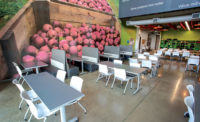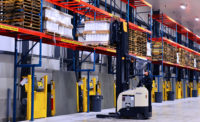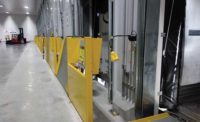A few years ago, the recession hit, forcing many cold storage construction projects to come to a halt. Rather than build anew, cold food processing companies instead upgraded, renovated and replaced existing buildings.
Today though, the cold storage construction industry is bouncing back to a different tune—one that rings of Greenfield construction, energy efficient technologies, automated systems and the ability to stay ahead of ever-changing consumer demands. That’s because today’s cold storage construction industry is packed with flexibility, forward-thinking and Millennials’ fresh ideas. And, the influx of government regulations, food safety rules and operating efficiency bring new ways of doing business.
Check out the trends responsible for revitalizing the cold storage construction industry.
The impact of FSMA
When it comes to facility design, the revised Food Safety Modernization Act (FSMA) brings clarity to the phrase “form must meet function,” according to Steve Tippmann, executive vice president of Tippmann Group, Fort Wayne, Ind.
“This encompasses things like food defense, sanitation and temperature controls within a facility,” he adds. “Sanitation is a major consideration in current regulations, including materials used and incorporation of practical design principles. Temperature controls are expected to be more specific and detailed with better room reporting and improved placement of temperature sensors. Things like site layout and perimeter infrastructure are [also] important elements of a food defense system.”
Employers must also develop and implement measures to control worker access to critical facilities and track and record product flows, says Joe Bove, vice president of design for Stellar, Jacksonville, Fla.
“The main focus of the FSMA rule is to prevent food contamination rather than respond to it,” he adds. “This shift from reactive to preventative includes contamination prevention on vehicles and transportation equipment moving food. A few notable steps include (but are not limited to) the installation of keypads, lockable-door fencing and cameras.”
Influx of energy efficient technologies
The implementation of energy efficiency protocols continues to be the norm, says Jack Michler, regional business manager for ESI Group USA, Hartland, Wis.
“Plants are opting to replace lighting with LED, install efficient hygienic air handling equipment with automated controls, reduce production waste and install water reclamation systems,” he says.
Likewise, many of today’s cold storage providers are shifting to more environmentally friendly practices, such as using CO2 and ammonia-based refrigeration systems and implementing solar panels, refrigerated trailer and electric car plug-ins, alternative fuels and water reclamation systems, says Charlie Stone, director of business development, food and beverage for McShane Construction Co., Rosemont, Ill.
“Cold storage users are shifting to more green and sustainable practices to appeal to changing consumer priorities, decrease costs and simply because it is the right thing to do,” Stone adds. “Many companies are looking for ways to become ‘zero waste’ and ‘zero energy,’ which means using only comparable resources to what you generate.”
Cold storage providers are also looking to conserve energy through building automation, decreased floor space, increased ceiling height, building security solutions and ergonomic designs, among other features, says Daniel Crist, vice president, A M King, Charlotte, N.C.
“It seems most companies are looking to conserve and improve efficiency in one form or another, whether it be through sustainability, efficiency or employee satisfaction and well-being,” he adds.
Building up, not out
According to “Construction Trends: Economies, Efficiencies, and Energy,” a construction trends piece produced by the Global Cold Chain Alliance, Alexandria, Va., the future of cold storage construction is taller.
Building up, not out, is ideal for several reasons, one being because plant locales are becoming more challenging to find.
“Often times, [the plant locations] come with built-in site restrictions due to geography and topography,” says Steve King, regional vice president for ESI. “A higher, smaller footprint building may not require as much on-site stormwater detention, leaving more space for parking and truck loading areas.”
Generally speaking, clients explore the option to go taller because it’s more cost-effective to build up than out, adds Luke Waite, ESI’s Midwest regional manager.
“Material handling equipment is driving this [trend of building up, not out] because equipment manufacturers are creating more efficient automated technologies that can handle larger loads of products and create efficient material flows, systems that help reduce building footprints as well as the amount of labor needed to operate.”
Meanwhile, dairy and meat processors are trending toward building new facilities over expansions, adds Waite.
“Clients are finding that the cost of upgrading/expanding their facility is not that far off from building new. They find they may have antiquated equipment or refrigeration systems and outdated food safety requirements that have to be updated,” he says. “A new facility allows clients a clean slate so to speak to meet the updated food safety requirements for product/people separation as well as sanitation while limiting any possible interruption of their existing production.”
And, for aged plants, trends are showing more Greenfield construction, says Michler.
“We are also seeing numerous expansions to existing facilities due to plants consolidating operations from dated satellite facilities, which in essence can also save on overall management costs,” he adds.
Automation makes room for new ways of doing business
When one trend comes to fruition, it makes room for others to do the same as well.
That’s why Tyler Cundiff, director of business development, Gray Construction, Lexington, Ky., says the future of the cold storage construction industry is more automated.
“For instance, the use of AS/RS systems automates this procedure, plus makes the tracking and use of inventory highly efficient for the company and the consumer,” Cundiff adds. “The future of cold storage is [also] more energy efficient since it allows for a low-energy cost for the life of the facility and also ensures a positive impact on the community.”
Automation also allows users to go more vertical, thus decreasing land requirements, says Stone.
“The ‘just-in-time’ mindset is having a growing impact on the cost of land, specifically in desirable areas with convenient transportation access that streamlines the distribution of goods,” he adds.
Furthermore, the market is driving the need to customize shipments and guarantee speed to market, says Humberto Lopez, executive vice president, The Weitz Co., Des Moines, Iowa.
“Distribution centers will be multi-purpose (cooler, freezer, dry) and will need to move and mix products based on specific order and to comply with demand,” he says.
Historically, food businesses had a hard time justifying automated processes due to the initial costs of implementation, says Stone, but that is changing.
“The increase in minimum wage, workers compensation, and in some instances, the underfunded pension liabilities are playing a key role in the shift toward automation. Today, there is a rising number of automated facilities that have eliminated the need for manual labor,” he adds. “As labor costs continue to rise, we will see more of these ‘lights out’ operations, and jobs will go from warehouse personnel to people maintaining the automation equipment and managing the data.”
How this year’s election impacts the future of the industry
With this year’s election coming up, several design-build firms foresee change, improvements and challenges. But, regardless of what party wins, the cold storage construction industry can expect an increase in regulations.
“For example, regulations will likely become more stringent pertaining to traceability and food handling, security for employees, visitor access and on-site tracking of non-company workers,” says Stone.
Likewise, issues such as energy, infrastructure and economic stability are important to the cold storage community, says Cundiff.
“We hope the new administration will focus on these challenges to encourage U.S. companies to grow domestically and to attract international companies to invest in the U.S.,” he adds.
Other factors that play around election cycles pertain to temporary restriction on capital spending leading up to the election and the uncertainty of the next administration’s regulatory policies, says Matt Hirsch, president of Primus Builders, Woodstock, Ga.
“[But], I don’t see this election affecting the design-build sector as a whole,” he adds. “Design-build continues to be on the forefront of contractual methods in the private sector, and is gaining large momentum in the public sector.”
On the other hand though, governmental gridlock can be good for business in a general sense, as it limits uncertainty for many different types of businesses and uncertainty can stifle aggressive investing, says Jim Caesar, regional vice president of Opus Design Build, LLC, Minnetonka, Minn.
“Elections bring new administrations, new legislation, tax laws, business regulations and tariffs or trade agreements, which can put businesses into a holding pattern as they wait for clarity in a changing business environment,” he adds.
Millennials make their mark
In Refrigerated & Frozen Foods’ July 2016 State of the Industry report, it was noted that Millennials are a hot new “trend.” But, how do they play into a design-build firm’s growth plan?
“We have found that [Millennials] tend to be more apt to work well in groups, and they use and adapt to new technology exceptionally well,” says Tippmann. “They have a strong desire and almost need to use technology for everyday business. Getting them involved in the process and rollout of new technology is a big benefit to both the company and the Millennials themselves.”
Plus, Millennials are more focused on sustainability, nutrition, organic and local sourcing than previous generations, says Caesar.
“We are seeing the grocery stores changing to meet this market with new brands, new presentations, new products and new branding,” says Caesar. “With so much change in the industry, the food processors and cold storage logistics providers are being more open-minded with their building requirements and looking for suggestions from the building community rather than single-sourcing the design to one set of consultants. Millennials pushing for new products in the marketplace are forcing new ideas in the building and engineering sectors.”
Case in point: Millennials are overtaking the Baby Boomers and Generation Xers.
They bring a lot of talent, futuristic thinking and modern technology, says Michler.
And, soon, Millennials will be the majority of the labor pool.
“Getting a younger workforce integrated into your company to help them learn and grow within the industry is vital for future successes,” says Waite.
Millennials are also a driving force behind the eat-fresh-and-local movement, says Nate Larose, director of project development for CMC Design-Build, Inc., Quincy, Mass.
“The local and fresh foods movement has become increasingly important to consumers, and they are willing to pay a premium for these products, so we believe that the ready-to-eat segment will continue to grow,” he says.
What the future holds
One of the most encouraging things in the cold storage industry this year is the constant evolution of innovation regarding design and construction of cold storage and food processing facilities, says Crist.
“Investment in robotics and automation are becoming the norm rather than the exception. In the past, design and construction of these types of facilities was rigid,” he adds. “In todays’ world, innovation has become a way of life and increasingly changing the way these facilities are built with regards to sustainability, efficiency and ergonomics.”
Market demands are also changing, thus transforming the needs of today’s—and tomorrow’s—clients.
“Cold storage facilities require an advanced, detailed analysis during the design phase to achieve operational cost savings,” says Bove. “Making these kinds of adjustments provides more flexibility during future expansions to accommodate either cooler- or freezer-based products.”
Whether it’s energy efficient technologies, automated systems or the ability to stay ahead of ever-changing consumer demands, fresh ideas and new perspectives continue to revitalize the cold storage construction industry.











